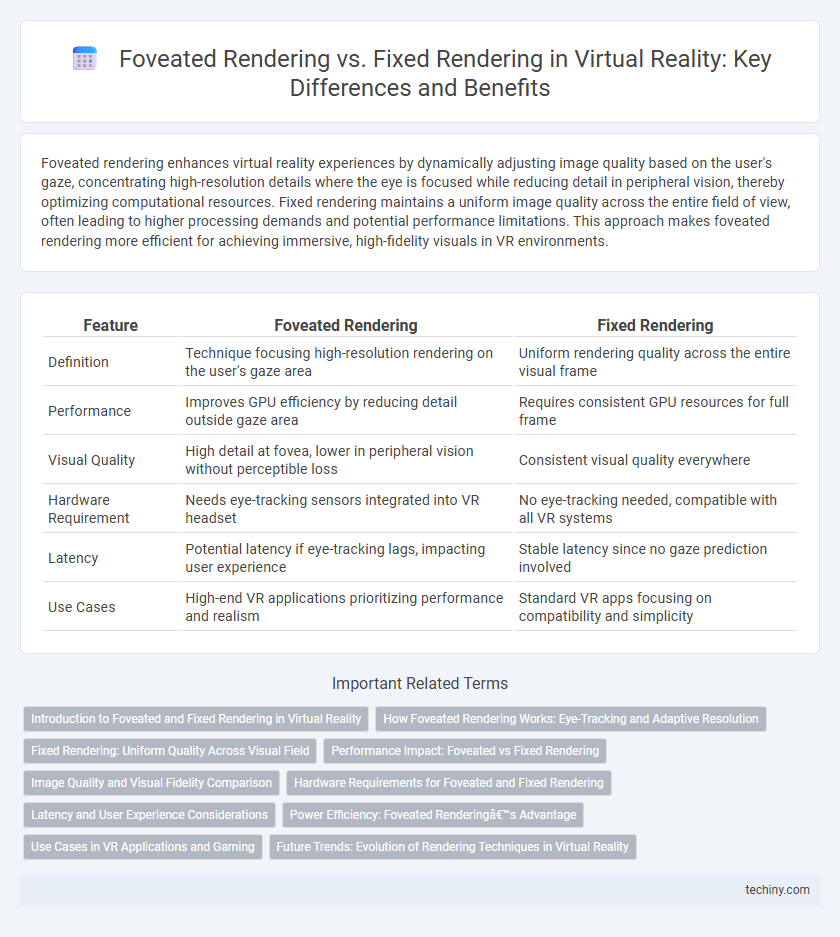Foveated rendering enhances virtual reality experiences by dynamically adjusting image quality based on the user's gaze, concentrating high-resolution details where the eye is focused while reducing detail in peripheral vision, thereby optimizing computational resources. Fixed rendering maintains a uniform image quality across the entire field of view, often leading to higher processing demands and potential performance limitations. This approach makes foveated rendering more efficient for achieving immersive, high-fidelity visuals in VR environments.
Table of Comparison
| Feature | Foveated Rendering | Fixed Rendering |
|---|---|---|
| Definition | Technique focusing high-resolution rendering on the user's gaze area | Uniform rendering quality across the entire visual frame |
| Performance | Improves GPU efficiency by reducing detail outside gaze area | Requires consistent GPU resources for full frame |
| Visual Quality | High detail at fovea, lower in peripheral vision without perceptible loss | Consistent visual quality everywhere |
| Hardware Requirement | Needs eye-tracking sensors integrated into VR headset | No eye-tracking needed, compatible with all VR systems |
| Latency | Potential latency if eye-tracking lags, impacting user experience | Stable latency since no gaze prediction involved |
| Use Cases | High-end VR applications prioritizing performance and realism | Standard VR apps focusing on compatibility and simplicity |
Introduction to Foveated and Fixed Rendering in Virtual Reality
Foveated rendering in virtual reality optimizes performance by concentrating high-resolution graphics on the user's focal point while rendering peripheral areas in lower detail, significantly reducing computational load. Fixed rendering maintains uniform image quality across the entire display, demanding higher processing power and limiting efficiency. Understanding these rendering techniques is essential for enhancing VR experiences with improved frame rates and visual fidelity.
How Foveated Rendering Works: Eye-Tracking and Adaptive Resolution
Foveated rendering enhances virtual reality performance by using eye-tracking technology to monitor the user's gaze and dynamically adjust the resolution, rendering high detail only where the eyes are focused. This adaptive resolution technique reduces computational load by lowering image quality in peripheral vision areas without compromising overall visual experience. The system relies on real-time tracking and swift rendering adjustments to maintain immersion and responsiveness in the VR environment.
Fixed Rendering: Uniform Quality Across Visual Field
Fixed rendering maintains uniform image quality across the entire visual field, ensuring consistent detail regardless of where the user focuses. This approach simplifies the graphics pipeline by rendering every pixel at the same resolution, avoiding the complexity of dynamic resolution adjustments. While it demands higher computational power compared to foveated rendering, fixed rendering delivers predictable performance and visual fidelity in virtual reality environments.
Performance Impact: Foveated vs Fixed Rendering
Foveated rendering significantly improves performance by reducing the rendering workload on peripheral vision areas, allowing higher frame rates and lower latency compared to fixed rendering. Fixed rendering processes the entire visual field at the same resolution, causing higher GPU resource consumption and potential frame drops. By dynamically adjusting image quality based on gaze tracking, foveated rendering enhances VR system efficiency and reduces power consumption.
Image Quality and Visual Fidelity Comparison
Foveated rendering significantly enhances image quality by selectively increasing resolution in the user's focal area while reducing detail in peripheral regions, optimizing visual fidelity with minimal performance cost. Fixed rendering maintains uniform resolution across the entire frame, often resulting in lower overall image sharpness and higher computational demands. Empirical studies show foveated rendering improves perceptual clarity where attention is focused, delivering superior visual fidelity in virtual reality environments.
Hardware Requirements for Foveated and Fixed Rendering
Foveated rendering requires eye-tracking hardware integrated into VR headsets to dynamically adjust image resolution based on the user's gaze, reducing GPU load by rendering high detail only where needed. Fixed rendering demands consistently high GPU performance to render the entire scene at uniform resolution, resulting in increased power consumption and thermal output. Advanced VR systems employing foveated rendering achieve improved efficiency and lower latency due to optimized resource allocation aligned with user focus.
Latency and User Experience Considerations
Foveated rendering significantly reduces latency by concentrating high-resolution graphics where the user's gaze is focused, optimizing GPU resources and enhancing frame rates compared to fixed rendering which processes the entire scene uniformly. This targeted approach lowers motion-to-photon latency, reducing motion sickness and increasing immersion for VR users. User experience benefits from smoother visuals and improved responsiveness, making foveated rendering a crucial technology in high-performance VR systems.
Power Efficiency: Foveated Rendering’s Advantage
Foveated rendering significantly improves power efficiency by selectively rendering high-resolution images only in the user's focal area while reducing detail in the peripheral vision, thereby lowering GPU workload and energy consumption. In contrast, fixed rendering requires full-resolution processing across the entire field of view, leading to higher power usage and increased thermal output. This optimization makes foveated rendering ideal for mobile VR headsets, extending battery life without compromising visual quality where it matters most.
Use Cases in VR Applications and Gaming
Foveated rendering optimizes performance by rendering high-resolution visuals only in the user's focal area, significantly reducing GPU load in VR applications and gaming, enhancing frame rates and immersion. Fixed rendering processes the entire frame at uniform resolution, resulting in higher computational demands and increased latency, which can hinder performance on less powerful hardware. Use cases for foveated rendering include complex, graphically intensive VR games and training simulations where visual focus is predictable, while fixed rendering suits simpler VR experiences with less dynamic gaze shifts.
Future Trends: Evolution of Rendering Techniques in Virtual Reality
Foveated rendering leverages eye-tracking technology to prioritize high-resolution graphics only in the user's focal area, vastly improving performance and visual quality compared to fixed rendering's uniform resolution approach. Future trends in virtual reality emphasize integrating AI-driven gaze prediction with foveated rendering, enabling even more efficient resource allocation and reduced latency. Emerging hardware advancements and machine learning models are expected to further enhance adaptive rendering techniques, pushing immersive VR experiences toward unprecedented realism and responsiveness.
Foveated rendering vs Fixed rendering Infographic

 techiny.com
techiny.com